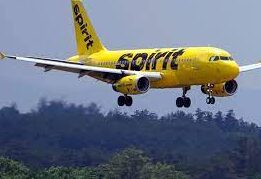Spirit Airlines has filed for bankruptcy protection for the second time in less than a year, raising fresh doubts about the future of the budget carrier known for its bright yellow jets and no-frills flying.
The Florida-based airline said Friday that its latest Chapter 11 filing comes after its earlier restructuring in March failed to fix deeper financial problems. Spirit has been burning through cash, reporting a $246 million loss in the three months ending in June. Last week, it tapped the full $275 million available on its credit line to stay afloat.
The move wasn’t a surprise. Spirit had already warned earlier this month that it might not be able to keep operating unless its finances turned around quickly.
“Since emerging from our previous restructuring, it has become clear that there is much more work to be done,” CEO Dave Davis said in a statement.
The company filed in bankruptcy court in New York and said it is working with creditors and considering new financing options to support operations during the process.
What went wrong
Analysts say Spirit’s first bankruptcy left big issues unresolved. Its costs remain far higher than revenue can cover, with operating expenses hitting $1.2 billion last quarter 118% of what the airline brought in.
The airline is also battling a dispute with aircraft lessor AerCap over 36 Airbus planes scheduled for delivery in 2027 and 2028.
As part of the restructuring, Spirit plans to pull back from some markets and shrink its fleet to cut debt and leasing costs. Those moves could save it hundreds of millions of dollars a year.
But the shakeup is also opening doors for rivals. Frontier Airlines has already added routes, while carriers like Southwest and United are watching closely for opportunities to snap up planes or other Spirit assets.
Still flying, for now
Despite the filing, Spirit said it will continue normal operations. Flights, ticket sales, and reservations remain active, and employees and contractors will still be paid. Vendors and suppliers will also be covered throughout the bankruptcy process.
Spirit first filed for bankruptcy last November, becoming the first major U.S. airline to do so since 2011. It emerged in March with less debt and a fresh $350 million investment from existing backers. The company also tried to shift its image by offering more premium travel options in hopes of tapping into the growing demand for comfort-focused flying.
That bet hasn’t paid off. A slowdown in U.S. travel spending which Spirit partly blamed on fallout from former President Donald Trump’s trade wars and federal budget cuts has undercut demand.
Its shares have plunged since relisting on the NYSE American exchange. On Friday, the stock dropped another 44% in after-hours trading, and Spirit said it expects to be delisted.
A turbulent history
Spirit’s roots date back to 1964 as a trucking company. It entered aviation in the 1980s as Charter One Airlines and rebranded as Spirit in 1992. For years, it thrived as a discount option for travelers willing to sacrifice comfort for low fares.
But the pandemic shifted consumer tastes toward more comfortable, experience-driven travel, leaving ultra-low-cost carriers struggling to keep up.
In its last restructuring, Spirit reduced debt by $795 million by converting it to equity and secured fresh investment. This time, the stakes are higher, with the airline facing pressure to prove whether its low-cost model can survive in a changing industry.






